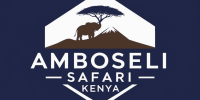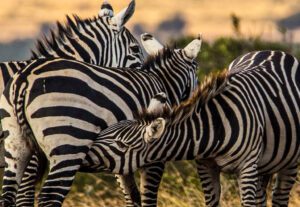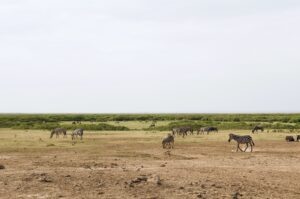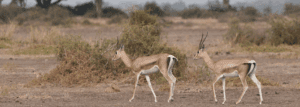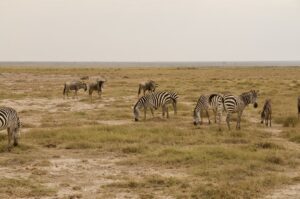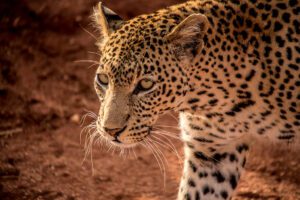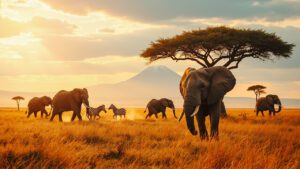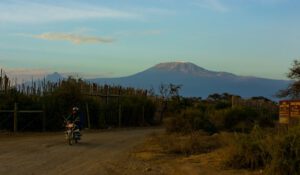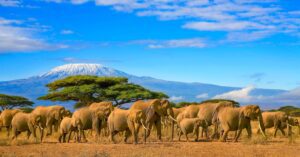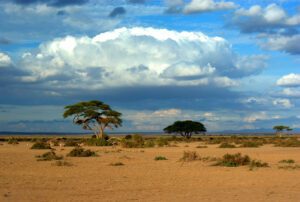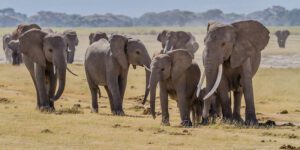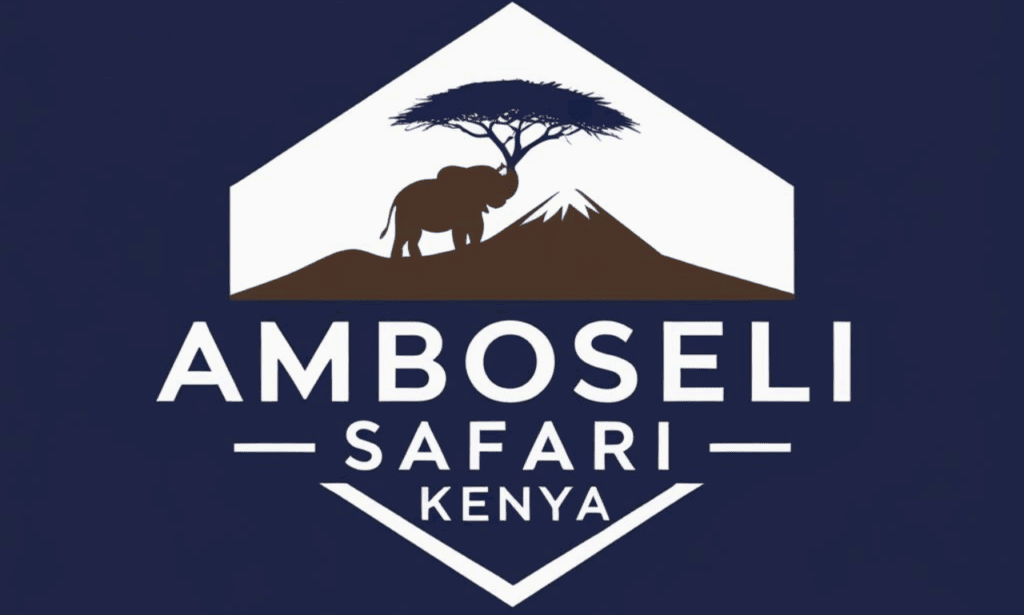Find the best Kenya safari packages and book your safari with the best safari companies.
What are the best national parks and reserves to visit in Kenya for a safari?
Kenya is one of the most iconic safari destinations in the world, and it has numerous national parks and reserves to explore. Each park offers something unique, from breathtaking landscapes to diverse wildlife. Here are some of the best spots:
- Maasai Mara National Reserve: Famous for the Great Migration, this is one of Kenya’s most popular parks. Every year, millions of wildebeest, zebras, and gazelles move in search of fresh grazing, crossing the Mara River. The Mara is also known for its “Big Five” (lions, leopards, elephants, rhinos, and buffalo). Imagine seeing a lion chasing prey or an elephant herd crossing the savannah, it’s magical.
- Amboseli National Park: If you dream of an amazing view of Mount Kilimanjaro, this is the park for you. Amboseli is known for its large herds of elephants and the breathtaking sight of these gentle giants with Africa’s tallest mountain in the background. You’ll also spot giraffes, lions, and cheetahs.
- Lake Nakuru National Park: This park is known for its flamingos that gather in huge numbers on Lake Nakuru. The lake often looks pink from afar! It’s also a great place to see white rhinos, lions, and leopards while enjoying beautiful acacia forests and waterfalls.
- Samburu National Reserve: Located in northern Kenya, Samburu is home to unique wildlife like Grevy’s zebras, gerenuks (long-necked antelope), and Somali ostriches. It’s also less crowded, so it feels more peaceful.
- Tsavo National Parks (East and West): Tsavo is one of Kenya’s largest parks and is split into two sections. Tsavo East is known for its red elephants (red because of the reddish soil they dust themselves with) and vast landscapes. Tsavo West has lush greenery, volcanic hills, and the iconic Mzima Springs, where hippos and crocodiles live.
These are just a few examples. Other noteworthy reserves include the Aberdare National Park (perfect for birdwatchers and forest lovers), Meru National Park (a hidden gem), and the Maasai private conservancies, which offer exclusive, less-crowded safari experiences.
What is the best time of year to go on a safari in Kenya?
The best time for a Kenyan safari depends on what you want to experience, but in general, June to October is the peak safari season. Here’s why:
- The Great Migration (July to September): If you want to witness the Great Migration in the Maasai Mara, these months are ideal. During this period, millions of wildebeest and zebras move into Kenya from Tanzania’s Serengeti. A major highlight is the river crossings, where animals brave crocodile-infested waters, a dramatic and unforgettable sight.
- Dry Season (June to October): This period is Kenya’s dry season, and the lack of rain means animals are easier to spot because they gather around water sources. The grasses are shorter, so your visibility is better. Plus, the weather is warm but not unbearably hot, with clear skies most days. Think sunny mornings and comfortable evenings.
- Short Rain Season (November to December): The short rains make the landscapes green and lush, creating beautiful photo opportunities. Wildlife is still relatively easy to find, and there are fewer tourists, meaning lower prices and less crowded parks.
- The “Green Season” (March to May): This is the rainy season, and while it’s the least popular time, it can still be rewarding. The parks are verdant, and baby animals are born during this time. However, heavy rains can make some roads hard to navigate, and certain lodges may close.
Ultimately, July to October is considered the absolute best for safaris, especially because of the migration. But if you prefer fewer crowds and lower costs, consider November, December, or early March. Remember, Kenya straddles the equator, so the weather is relatively mild year-round compared to other places in the world.
What wildlife can you expect to see on a Kenyan safari?
Kenya is a wildlife lover’s dream! You’ll find a huge variety of animals, both common and rare, with the dramatic African savannah as their backdrop. Here’s what you can expect:
- The Big Five: This group includes lions, leopards, elephants, rhinos, and buffalo. They’re called the “Big Five” because they were historically considered the most challenging animals to hunt (thankfully, today they’re celebrated for conservation efforts). You’ll often see lions lounging in pride or buffalo herds grazing.
- Wildebeest and Zebras: These two animals are stars of the Great Migration. If you visit the Maasai Mara between July and September, you’ll see massive herds moving across the land in search of fresh grass.
- Giraffes: Kenya is home to different species of giraffes, like the Maasai and reticulated giraffes. Watching them gracefully stride across the plains or nibble on acacia trees is a highlight.
- Cheetahs and Leopards: Cheetahs, known for their speed, are often spotted hunting in Kenya’s parks like the Maasai Mara or Samburu. Leopards, though harder to see due to their stealthy nature, can sometimes be found lounging in tree branches.
- Elephants: Amboseli National Park is famous for its elephant herds. Watching elephants interact with their families is both heartwarming and fascinating.
- Rhinos: Rhinos are more elusive but can be seen in places like Lake Nakuru (white rhinos) or Ol Pejeta Conservancy, where both black and white rhinos are protected.
- Unique Wildlife in Specific Parks: In Samburu, you might encounter the “Samburu Special Five”: Grevy’s zebra, Somali ostrich, gerenuk, Beisa oryx, and reticulated giraffe. These animals are unique to the northern part of the country.
- Birds: Kenya is a birder’s paradise, with over 1,000 bird species. Flamingos on Lake Nakuru and Lake Bogoria are highlights, but you’ll also find raptors, storks, and colorful species like lilac-breasted rollers.
Whether it’s watching a lion roar at sunset or spotting a baby elephant trailing its mother, the diversity and abundance of wildlife in Kenya create unforgettable safari memories.
What are the different types of safaris available in Kenya?
Kenya offers a wide variety of safaris catering to different preferences, budgets, and levels of adventure. A safari is not a one-size-fits-all experience – there are options for everyone, from high-luxury travelers to those seeking a more rugged, back-to-nature journey. Here’s an overview:
- Game Drive Safaris: This is the most common type of safari. You ride in specially designed vehicles (like 4×4 Land Cruisers or safari vans) with a guide. These vehicles typically have open roofs for better wildlife viewing, and guides are trained to find animals and share fascinating facts about them. Game drive safaris are usually conducted in national parks and reserves like the Maasai Mara, Amboseli, or Tsavo. They can be half-day, full-day, or even multiple-day excursions.
- Walking Safaris: If you prefer to get closer to nature, walking safaris are an incredible option. Accompanied by a guide, you walk through wildlife areas on foot, learning about animal tracks, plants, and the ecosystem. While walking safaris usually do not get you as close to large predators for safety reasons, you can still see many animals at a safe distance and get a feel for the African wilderness.
- Balloon Safaris: For a truly breathtaking experience, you can take a hot air balloon ride over a park like the Maasai Mara. Imagine floating silently above the savannah as the sun rises, watching herds of wildebeest, elephants, and other animals below. This is a premium, once-in-a-lifetime safari experience that many travelers hold dear.
- Night Safaris: For those curious to see what happens when the sun sets, night safaris offer the opportunity to spot nocturnal animals like leopards, civets, and owls. Night safaris are usually conducted in private conservancies, as they are not permitted in most national parks.
- Boat Safaris: Found in areas with large lakes or water systems, boat safaris allow you to explore habitats along the water. For example, at Lake Naivasha or Lake Victoria, you’ll be able to see hippos, crocodiles, and a wealth of birdlife like pelicans or fish eagles.
- Cultural Safaris: These focus on interacting with Kenya’s local communities, such as the Maasai, Samburu, or Turkana tribes. You’ll learn about their customs, traditions, dances, and daily lives. These types of safaris often complement a traditional game drive experience.
- Photography Safaris: Specifically geared toward photographers, these safaris specialize in getting you close to animals at the right time of day for the best light and angles. Many are led by professional wildlife photographers who can guide you in taking the perfect shot.
- Luxury Fly-In Safaris: Instead of spending hours driving between parks, you can take small planes to remote and pristine safari lodges. This saves time and is perfect for those seeking a higher-end, more comfortable experience.
Each type of safari has its own unique appeal, and you can often mix and match different styles. Whether you’re looking for relaxation, adventure, or immersion in culture, Kenya has a perfect safari waiting for you.
How safe is it to go on a safari in Kenya?
Going on a Kenya safari is generally very safe, especially when you follow guidelines and choose established safari companies. Visitors from around the globe enjoy safari trips in Kenya every year without trouble, thanks to strict safety protocols, experienced guides, and the country’s commitment to tourism. Let’s break down safety concerns and precautions:
- Wildlife Safety: The most exciting (and potentially dangerous) aspect of a safari is the wildlife. It’s important to remember that you’re in the animals’ natural habitat. Following your guide’s instructions is critical – they ensure your safety by keeping a respectful distance from the animals. For example, if lions are near, you must stay in the vehicle, avoid sudden movements, and remain quiet to avoid startling them.
- Park Regulations: Kenyan parks and reserves are well-regulated. Guides are licensed and trained in handling wildlife encounters, ensuring you enjoy the experience without taking unnecessary risks. Parks also monitor visitor areas regularly for any potential hazards.
- Health and Malaria Prevention: Some areas in Kenya are malaria zones, so it’s recommended to take antimalarial medication and use insect repellent. Vaccinations for yellow fever and other illnesses may also be required. Drinking bottled or filtered water and eating food from trusted sources is advised to avoid stomach issues.
- Crime and Security: Tourist areas and safari parks are generally safe, with local police and park rangers ensuring security. While larger towns might have petty theft in crowded markets, this is unlikely to affect you during a safari. Still, it’s wise to keep valuables secure and avoid displaying expensive items unnecessarily.
- Transportation Safety: Safari vehicles are designed for challenging conditions, like rough dirt roads in the parks. Drivers are skilled in managing these terrains. Air travel for fly-in safaris is also tightly regulated, with highly experienced pilots operating the planes.
Examples of safety practices include staying inside your safari truck during game drives, avoiding nighttime walking in the bush, and relying on your guide’s instructions at all times. Many safari lodges and camps even provide escorts (often Maasai guards) to walk you safely to and from your tent at night when animals might be wandering.
In summary, Kenya is a safe place for a safari as long as you follow the guidelines, choose a reliable operator, and stay aware of your surroundings. With a little preparation and care, you can enjoy an unforgettable adventure without concern.
What are the costs associated with a safari in Kenya?
The cost of a safari in Kenya varies widely, depending on factors like the duration, level of luxury, choice of park or reserve, and whether you join a group or opt for a private experience. Here’s a breakdown to help understand where your money goes:
- Park Entry Fees: Each park or reserve charges an entry fee, which usually ranges from $60 to $80 per adult per day. For example, the Maasai Mara charges $70, while Amboseli is about $60. Conservancies, which are private wildlife areas, may have even higher fees but offer more exclusive experiences.
- Accommodation Costs: Lodging options vary from budget to ultra-luxury. A basic campsite might cost around $20–$50 per night, while mid-range lodges are $150–$400 per night. High-end lodges and tented camps, such as those with private pools and gourmet meals, can cost $500–$2,000 per night per person.
- Guides and Transport: The cost of hiring a guide and safari vehicle is typically built into packages. Group safaris are more budget-friendly, costing around $150–$300 per day per person. Private safaris, though costlier (around $400–$1,000+ per day), offer more customized experiences.
- Food and Drinks: Many safari packages include meals, especially at all-inclusive lodges. Budget travelers may spend around $15–$40 daily on food if not included.
- Domestic Flights: Fly-in safaris are faster but costlier. A round trip to the Maasai Mara from Nairobi can cost $300–$500 per person.
- Additional Costs: Extras like walking safaris, balloon rides (which cost $450–$600 per person), or tipping guides and camp staff can add up. Tips typically range from $10–$20 per staff member per day.
- International Flights: Flying to Nairobi, Kenya’s main entry point, varies depending on where you’re coming from. Expect to pay $700–$1,500 for economy class from places like Europe or North America.
In total, a budget safari might cost around $1,000–$2,000 for a few days, while highly luxurious safaris could go upwards of $5,000. While this might sound expensive, remember that safaris are an investment in a unique experience, with much of the money going toward wildlife conservation and supporting local communities.
What should you pack and bring for a Kenyan safari?
Packing for a Kenyan safari is all about being prepared, comfortable, and ready for different weather conditions, activities, and wildlife experiences. Keep in mind that safari destinations in Kenya can vary from hot savannahs to cooler highlands, and you’ll likely be out and about for long stretches of time. Here’s what you need:
- Clothing: Bring lightweight, neutral-colored clothes (like greens, browns, and khakis) to blend in with the environment and avoid attracting insects or startling the animals. Long-sleeved shirts and pants are great for sun protection and evening mosquito defense. A hat and sunglasses are essential to protect against the strong African sun. Don’t forget a warm jacket or sweater for cool mornings and evenings, especially if you’re visiting places like the Maasai Mara or Amboseli, which can get chilly.
- Footwear: Comfortable walking shoes or hiking boots are a must, especially for game walks, and casual shoes or sandals work well for lounging at the camp or lodge.
- Travel Gear: Binoculars are crucial for spotting wildlife up close, like a distant lion or a bird in a tree. If you love photography, pack a good camera with a zoom lens. A flashlight or headlamp can also come in handy at night in camps and lodges.
- Personal Essentials: Don’t forget sunscreen, insect repellent, lip balm, and a small first aid kit for minor injuries or ailments. Pack prescription medications or motion sickness pills if needed.
- Daypack: Carry a small backpack for safaris to hold your water bottle, snacks, sunscreen, camera, and any personal essentials. Hydration is super important!
- Extras: Don’t forget a travel power adapter for charging devices, a reusable water bottle, and a notebook or journal to jot down wildlife sightings or memorable moments.
By packing strategically, you’ll be ready for just about anything the safari throws your way!
How can you choose a reputable safari operator in Kenya?
Choosing the right safari operator is critical to ensuring you have a safe, enjoyable, and well-organized experience in Kenya. Since the market is full of options, you’ll want to focus on a few key aspects:
- Look at Reviews and Recommendations: Start by researching online reviews on platforms like TripAdvisor or SafariBookings. Read what other travelers have said about their experiences. Word-of-mouth recommendations from friends or family are also reliable.
- Check for Accreditation and Memberships: Reputable operators in Kenya are often part of professional associations such as the Kenya Association of Tour Operators (KATO). These memberships indicate the operator meets quality and safety standards.
- Consider Specializations: Operators offer various safari options such as luxury safaris, family-friendly trips, or photographic safaris. Choose one whose expertise aligns with what you’re looking for. For example, if you’re keen on seeing the Big Five, pick someone with a proven wildlife-focused itinerary.
- Transparency in Costs: Be wary of deals that seem too good to be true. A reputable operator will clearly explain their pricing and include costs for transport, park fees, accommodation, and meals. Hidden fees or vague pricing info are red flags.
- Experienced Guides: The quality of your safari guide makes a huge difference. Look for operators who hire knowledgeable, experienced guides who understand the wildlife, environment, and even the local culture.
- Sustainability Practices: Choose operators that value conservation, respect local communities, and follow ethical practices, like avoiding overcrowding animals or off-road driving in sensitive areas.
Ask questions before booking to make sure the operator prioritizes safety, customizes trips to your needs, and gives you a detailed plan. A good operator can truly make your Kenyan safari unforgettable.
Are guided safaris better than self-drive safaris in Kenya?
In most cases, guided safaris are a better option than self-drive safaris in Kenya, especially if it’s your first visit. Here’s why:
- Expert Knowledge: On a guided safari, you’ll have an experienced guide who knows the parks, understands animal behavior, and can lead you to the best wildlife spots. Guides are trained to spot animals that you might miss on your own, like a well-camouflaged leopard resting in a tree.
- Navigation and Logistics: Kenya’s game reserves and national parks can be vast and confusing to navigate. Guided tours eliminate the stress of figuring out maps, road conditions, and rules. For example, in the Maasai Mara, there are nearly no signposts, so getting lost is easy without a guide.
- Safety: Safari guides are trained to handle risky situations, such as encountering dangerous animals like elephants or lions. On a self-drive safari, you’re on your own, and you might accidentally put yourself in harm’s way by not understanding animal behavior or the best ways to observe from a distance.
- Convenience: Guided safaris often include pre-arranged accommodations, meals, and park permits, so everything is managed for you. You can just sit back and enjoy the experience without worrying about logistics.
- Cultural Insights: Safari guides can also share stories about the local environment, history, and even traditions of the nearby tribes, like the Maasai or Samburu people, a cultural aspect you’d miss on a self-drive.
Self-drive safaris can still appeal to more adventurous or experienced travelers, especially those on a budget or who prefer complete independence. But if you’re new to safaris, want a stress-free trip, or hope to maximize wildlife sightings, a guided safari is hands-down the better choice.
What is the Great Migration, and how can you witness it in Kenya?
The Great Migration is one of the most impressive wildlife events in the world, often referred to as the “World Cup of Wildlife.” It takes place between Kenya and Tanzania, involving over two million animals, wildebeest, zebras, and other grazers, moving in a massive loop in search of fresh grazing land and water. This natural phenomenon isn’t just about the scale of the animals migrating; it also includes the incredible drama of survival, as predators like lions, crocodiles, and cheetahs follow the herds. For those planning a Kenya safari, this event is a must-see.
To witness the Great Migration in Kenya, the best place to visit is the Maasai Mara National Reserve. The migration usually reaches the Mara around July to October, when the herds cross the Mara River from Tanzania’s Serengeti. These river crossings are famous but also perilous; many animals fall victim to crocodiles lying in wait or the sheer exhaustion of their journey. Witnessing this spectacle requires some luck and precise timing, as the crossings aren’t scheduled events, it depends on animal behavior and environmental conditions, making it a thrilling aspect of any safari tour.
To enhance your chances of witnessing this event, consider working with a reputable safari company that specializes in migration viewing. They can guide you to areas where the action is most likely. Hot air balloon safaris over the Mara are also a fantastic way to see the vast herds from above, adding a unique perspective to your Kenya safari itinerary.
Picture thousands of wildebeest plunging into the river while crocodiles lurk beneath the surface, or imagine hearing the thunderous sound of hooves stretching as far as the eye can see. This experience combines pure wonder with raw nature’s beauty, making it unforgettable and a highlight of your wildlife adventures in Africa.
What cultural experiences or interactions with local tribes can you have during a Kenyan safari?
Kenya is not only about the incredible wildlife; it’s also rich in culture and home to several fascinating tribes like the Maasai, Samburu, Kikuyu, and Turkana. Interacting with these communities provides a deeper understanding of Kenyan life, traditions, and history. Most safaris incorporate optional visits to local villages, where you can learn directly from the people what life is like in these regions.
One of the most common cultural experiences is meeting the Maasai people, who are well-known for their brightly colored clothes, elaborate beadwork, and traditional practices like jumping dances. On village visits, you’ll learn about their everyday lives, how they herd cattle, build shelters, and celebrate special occasions. For instance, the Maasai have a unique diet that includes milk and blood from their cattle, something they have historically relied upon for nutrition in their arid environment.
Another tribe you might interact with is the Samburu, who have many similarities with the Maasai but live further north. The Samburu have traditional ceremonies where they perform dances and songs, and you’ll also see their intricate beadwork and colorful attire.
If you’re heading towards Lake Turkana, you can visit the Turkana people, known as “the people of the jade sea.” They have a rich fishing culture, and their houses made from woven palm fronds are unique.
These cultural experiences help travelers appreciate the significant connection between Kenyan communities and the natural world. Always make sure your tour operator fosters sustainable tourism, where visits benefit the local people economically while maintaining respect for their traditions and privacy.
What accommodation options are available while on a safari in Kenya?
Safari accommodations in Kenya cater to a wide range of preferences and budgets, offering everything from basic camping to luxury lodges. These accommodations are designed thoughtfully to immerse you in nature while still keeping you comfortable. Here are the main options to consider:
- Luxury Lodges: These are high-end, hotel-style lodges located within reserves or just outside them. They typically feature private rooms, fine dining, swimming pools, and sometimes spa services. Imagine unwinding in a beautiful suite with floor-to-ceiling windows overlooking a savannah sunset or hearing lions roar in the distance as you drift off to sleep.
- Tented Camps: Tented camps come in varying luxury levels, but all provide a unique “close-to-nature” feel. Luxury tented camps, for instance, are like hotel rooms under fabric, complete with modern bathrooms, gourmet meals, and comfortable beds. Simpler versions have basic facilities while still offering warmth and authenticity.
- Mobile Camps: These are temporary setups, usually following wildlife movements, meaning you might stay in a pop-up camp located right where the action is. These are perfect for people eager to stay closer to animals, especially during the Great Migration.
- Budget Campsites: If you are looking for something cost-effective, you can enjoy camping in the wilderness. You’ll need to bring your own gear or rent it, but camping under the starlit African sky surrounded by wildlife sounds is a magical experience.
- Eco-Lodges: For eco-conscious travelers, Kenya boasts several lodges that minimize their environmental impact. These may use solar power, recycle resources, or implement policies that benefit local communities.
Example: If you’re in the Maasai Mara, you might stay at the illustrious Fairmont Mara Safari Club for luxury or opt for eco-conscious options like Basecamp Explorer, which works closely with local people to sustain the community. Whatever you choose, the accommodations aim to blend comfort with an authentic wildlife experience.
